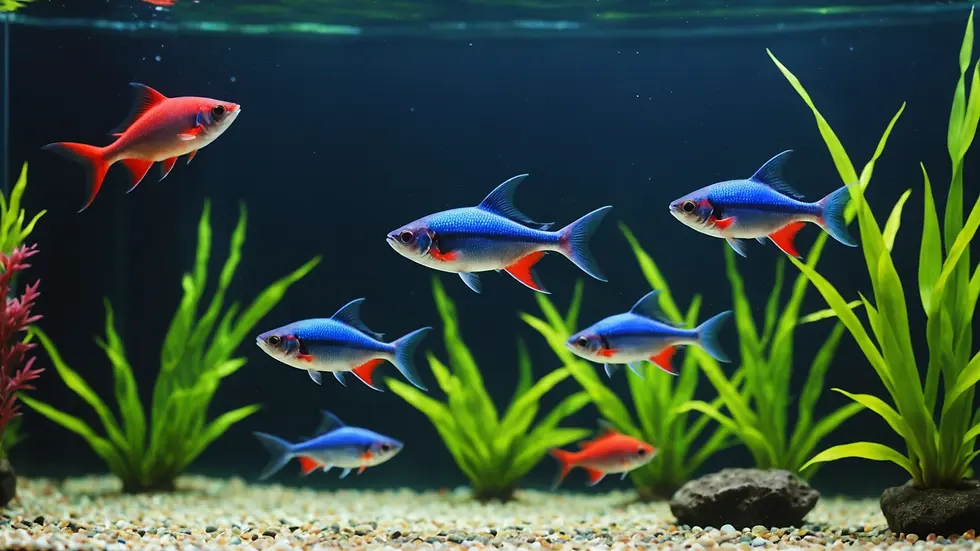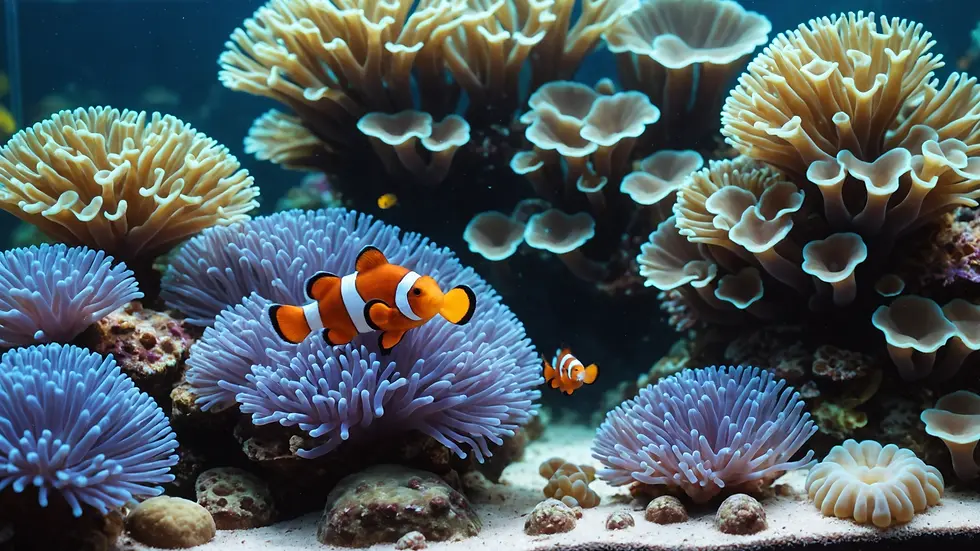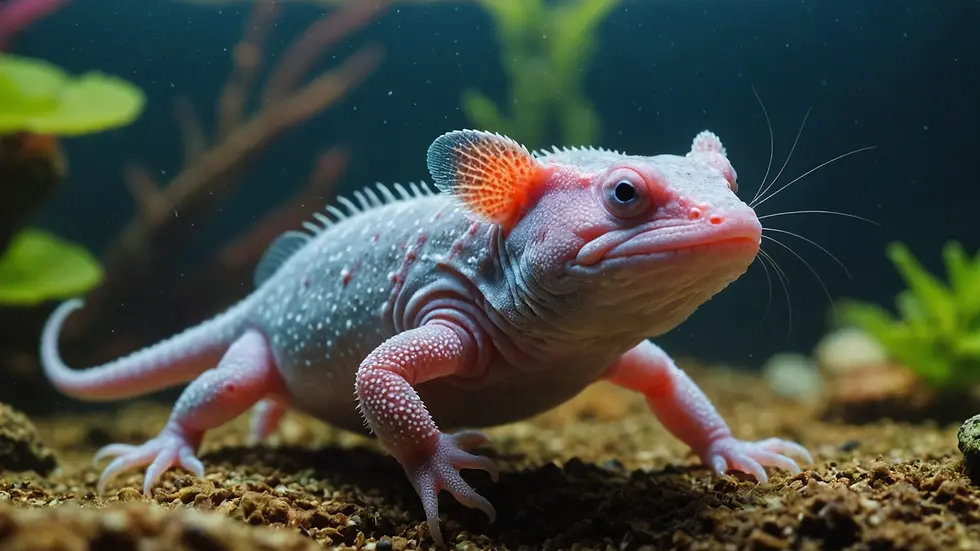Exploring the Enigmatic Diversity of Aquarium Fish: A Journey into the Unknown
- Jyotiraj Borah
- Feb 5
- 5 min read
Aquarium fish captivate our attention with their vivid colors and unique behaviors. They are not just lively inhabitants of glass tanks; they are vital parts of complex ecosystems that thrive within our oceans and rivers. Each species has its own fascinating characteristics, contributing to both the beauty and health of their environments. In this post, we will take a closer look at various types of aquarium fish, exploring their traits, habitats, and the specific care they require.
The Allure of Freshwater Fish
Freshwater fish inhabit rivers, lakes, and streams, offering a diverse array for aquarium hobbyists.
Community Fish
Community fish are typically peaceful and social, making them great choices for beginners. Here are some popular options:
Neon Tetra: These small, dazzling fish display vibrant blue and red colors and thrive in groups. When kept in schools of at least six, they create a stunning visual effect in well-planted tanks with gentle currents. Studies show they thrive in environments with a temperature between 70°F and 81°F.
Guppies: Renowned for their lively swimming and colorful tails, guppies are adaptable and easy to care for. They can reproduce quickly, which means a small investment can multiply rapidly in a home aquarium. An aquarium with 10 guppies can easily yield up to 50 fry in a month if conditions are right.
Zebra Danio: With their bold stripes and playful nature, Zebra Danios are not only fun to watch but also incredibly hardy. They adapt well to varying water conditions, making them suitable for beginners looking for resilient fish.

Cichlids
Cichlids are recognized for their intelligence and intricate behaviors. Though beautiful, they can be territorial, requiring careful tank management.
Oscars: These intriguing fish have unique personalities and are capable of recognizing their owners. They need at least a 55-gallon tank due to their size and can become aggressive toward smaller fish, making them a solitary option or a centerpiece in larger tanks.
Angelfish: With their elegant shape, angelfish are common in many aquariums. They prefer stable water conditions and need at least a 30-gallon tank to thrive, as they can grow up to 6 inches in length and require space to establish territories.
African Cichlids: Known for their bright colors and aggressive behavior, African Cichlids from the Great Lakes of Africa necessitate a meticulously planned tank. Keeping a mix of species that can tolerate similar conditions while providing ample hiding places is crucial for reducing aggression.
The Enchantment of Saltwater Fish
Saltwater fish are renowned for their stunning colors and engaging behaviors, but they usually require more specialized care.
Reef Fish
Reef fish are integral to coral reef ecosystems, showcasing vibrant appearances and lively behaviors.
Clownfish: Famous from films, clownfish form symbiotic relationships with anemones. They do best in pairs or small groups and can survive in various conditions, but they thrive in tanks of at least 20 gallons.
Tang: These fish are known for their bright colors and distinct shapes. Tangs require large tanks, typically 75 gallons or more, with plenty of space for swimming and a suitable diet high in algae for optimal colors.
Butterflyfish: Delicate yet stunning, these fish are appealing for their vibrant patterns. However, they can be challenging to keep due to their strict dietary needs and sensitivity to water quality. A tank with well-established live rock and coral is ideal for these fish.

Predatory Fish
Predatory fish may be both captivating and challenging for aquarists due to their aggressive tendencies.
Lionfish: Recognized for their stunning fins and striking colors, lionfish are intriguing yet venomous. Seeking compatible tank mates is critical, as they can intimidate smaller fish.
Groupers: These robust fish can grow significantly and boast bold personalities. A large tank with plenty of hiding spots and a diet rich in meaty foods ensures their health.
Sharks: While most shark species are unsuitable for home aquariums, smaller types like the bamboo shark can be a great addition to larger tanks. They need ample space and should be the only large fish in the tank to avoid conflicts.
Specialty Fish: Oddities and Unconventional Choices
For those looking to explore rare and unique fish, many options break away from the traditional choices.
Oddball Fish
Some fish capture interest with their exceptional characteristics and behaviors.
Pufferfish: Known for their ability to puff up, pufferfish can bring a unique flair to your aquarium but require specific water quality and diet. Most species need a minimum of 30 gallons to thrive.
Bichir: An ancient fish resembling an eel, the bichir can survive in low-oxygen environments and is intriguing to watch. They require plenty of space to swim and a diet that includes both meaty and plant-based foods.
Axolotl: Technically an amphibian, axolotls are fascinating additions to aquariums. They can regenerate limbs and thrive in environments similar to low-flow freshwater fish. They require a tank of at least 20 gallons with cool water temperatures around 60°F to 64°F.

Small Fish
Smaller species can add vibrant energy to any aquarium environment and often have distinct care requirements.
Betta Fish: Known for their beautiful flowing fins and array of colors, bettas are territorial and often need solitary tanks. While they can adapt to smaller environments, maintaining high water quality is crucial to their health.
Microrasbora: These tiny, peaceful fish are perfect for nano tanks. Their shimmering bodies and social nature make them an ideal choice for creating a small, dynamic community.
Dwarf Gourami: Unlike many other species, dwarf gouramis are peaceful and relatively easy to care for, which are attractive traits for aquarists seeking community fish.
The Aquarist’s Guide to Choosing Fish
Choosing the right fish for your aquarium can seem overwhelming due to the vast options available.
Assessing Your Aquarium's Environment
Understanding your tank's size, water parameters, and filtration system is vital before introducing new fish.
Tank Size: Larger tanks offer better stability for water conditions and a wider variety of fish choices. Smaller tanks typically limit options and necessitate careful planning for compatibility.
Water Parameters: Different fish have unique needs in terms of pH, temperature, and hardness. Researching specific requirements is vital for each species you consider adding.
Filtration and Equipment: Adequate filtration is key to maintaining quality water. Prioritize understanding the needs of your chosen fish and ensuring your setup provides proper filtration, heating, and lighting for optimal conditions.
Compatibility and Behavior
Understanding interpersonal dynamics among species can help minimize stress within your aquarium.
Community Compatibility: Some fish are better suited for community tanks than others. Research compatibility before introducing new species to maintain harmony.
Aquascaping: Establishing hiding areas, plants, and structures in your aquarium creates a more natural habitat, reducing stress levels and encouraging healthier interactions.
Our Final Thoughts on Aquarium Fish
The aquarium fish world opens a portal into diverse aquatic ecosystems. Each fish species contributes uniquely to the beauty and complexity of its environment, offering endless opportunities for learning and enjoyment. Whether drawn to the bright colors of freshwater community fish, the sophistication of saltwater species, or the extraordinary oddities, there is a perfect aquarium fish waiting for you.
By understanding the unique characteristics and needs of various fish, aquarists can build healthy habitats that celebrate the vibrant diversity of aquatic life. As you embark on your journey into this captivating realm, consider the specific requirements and compatibility of each species to ensure a thriving and harmonious aquarium. Happy fishkeeping!




Comments